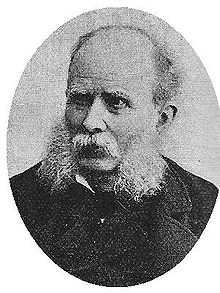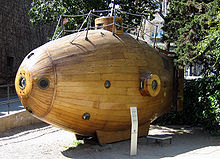- Narcís Monturiol i Estarriol
-
Narcís Monturiol Estarriol (Catalan pronunciation: [nərˈsis muntuɾiˈɔɫ]) (28 September 1819 – 6 September 1885) was a Spanish Catalan intellectual, artist and engineer. He was the inventor of the first combustion engine-driven submarine, which was propelled by an early form of air-independent propulsion.
Contents
Biography
Monturiol i Estarriol was born in the city of Figueres, Catalonia, Spain. He was the son of a cooper. Monturiol went to high school in Cervera and got a law degree in Barcelona in 1845. He solved the fundamental problems of underwater navigation. In effect, Monturiol invented the first fully functional submarine.[1][2]
Monturiol never practiced law, instead turning his talents to writing and publishing, setting up a publishing company in 1846, the same year he married his wife Emilia. He produced a series of journals and pamphlets espousing his radical beliefs in feminism, pacifism, and utopian communism. He also founded the newspaper La Madre de Familia, in which he promised "to defend women from the tyranny of men" and La Fraternidad, Spain's first communist newspaper.
Monturiol's friendship with Abdó Terrades led him to join the Republican Party and his circle of friends included such names as musician Josep Anselm Clavé, and engineer and reformist Ildefons Cerdà. Monturiol also became an enthusiastic follower of the utopian thinker and socialist Étienne Cabet; he popularised Cabet's ideas through La Fraternidad and produced a Spanish translation of his novel Voyage en Icarie. A circle formed round La Fraternidad raised enough money for one of them to travel to Cabet's utopian community, Icaria.
Following the revolutions of 1848, one of his publications was suppressed by the government and he was forced into a brief exile in France. When he returned to Barcelona in 1849, the government curtailed his publishing activities, and he turned his attention to science and engineering instead.
A stay in Cadaqués allowed him to observe the dangerous job of coral harvesters where he even witnessed the death of a man who drowned while performing this job. This prompted him to think of submarine navigation and in September 1857 he went back to Barcelona and organized the first commercial society in Catalonia and Spain dedicated to the exploration of submarine navigation with the name of Monturiol, Font, Altadill y Cia. and a capital of 10,000 pesetas.
In 1858 Monturiol presented his project in a scientific thesis titled The Ictineo or fish-ship. The first dive of his first submarine, Ictineo I, took place on September 1859 in the harbour of Barcelona.
Ictineo I
Main article: Ictineo IIctineo I had dimensions of 7 m (23 ft) long, 2.5 m (8 ft 2 in) wide, and 3.5 m (11 ft) deep, and its intended use was to ease the harvest of coral. It is likely that it was inspired by the prototype Brandtaucher of Wilhelm Bauer, that had dived in 1851, as Monturiol studied all the available science of submersibles. The prow was equipped with a set of tools suited to the harvest of coral. During the summer of 1859 Monturiol performed more than 20 dives in the Ictineo, with his business partner and shipbuilder as crew. The Ictineo I turned out to possess good handling, but its top speed was disappointing, as it was limited by the power of human muscles.
The technical success of this submersible brought popular enthusiasm but no support from the government. As a result, Monturiol wrote a letter to the nation and encouraged a popular subscription which raised 300,000 pesetas from citizens of Spain and Cuba.
Ictineo I was eventually destroyed by accident in January 1862, after completing some fifty dives, when a cargo vessel ran into it while it was berthed. With the money obtained from the subscription, the company La Navegación Submarina was formed with the objective of developing the Ictineo II.
A modern replica of the Ictineo I stands in the garden entrance to the Marine Museum in Barcelona.
Ictineo II
Main article: Ictineo IIIntended as an improved version of the Ictineo I, the Ictineo II was launched on 2 October 1864. The Ictineo II made her maiden voyage under human power on 20 May 1865, submerging to a depth of 30 metres (98 ft). Dissatisfied with the limitations of human propulsion, Monturiol, after much experimentation, invented a chemical combination that generated both heat and oxygen when mixed. With the heat generated by this mixture he hoped to drive a small steam engine, which could also be powered with coal during surface operation.
Monturiol envisaged a new vessel custom-built to house his new engine, which would be entirely built of metal with the engine housed in its own separate compartment. However, due to the state of his finances, construction of a new vessel was out of the question, and instead he managed to assemble enough funds to fit the engine into the Ictineo II.
On 22 October 1867, Ictineo II made its first surface journey under steam power, averaging 3.5 knots (4.0 mph) with a top speed of 4.5 knots (5.2 mph). Two months later, on 14 December, Monturiol submerged the vessel and successfully tested his anaerobic engine but without attempting to travel anywhere.
On 23 December that same year, Monturiol's company went bankrupt and could attract no more investment.[3] The chief creditor called in his debt, and Monturiol was forced to surrender his sole asset, the Ictineo II. The creditor subsequently sold it on to a businessman, and the authorities, who taxed all ships, issued its new owner with a tax bill. Rather than pay the bill, he dismantled the submarine and sold it for scrap.[4] A replica can be seen at the harbour of Barcelona.
Later life
In 1868 Monturiol returned to political life. A member of the Partido Federal, he was a deputy in the Constituent Assembly of the First Spanish Republic (1873), and shortly afterwards became the director of Fabrica Nacional del Timbre (National Stamp Factory) in Madrid for a few months, where he implemented a process to speed up the manufacturing of adhesive paper. Monturiol's other inventions included a system for copying letters, a continuous printer, a rapid-firing cannon, a system to enhance the performance of steam generators, a stone cutter, a method for preserving meat, and a machine for making cigarettes.[5]
Monturiol died in 1885, in Sant Martí de Provençals, now a suburb of Barcelona.
Legacy
No other submarine employed an anaerobic propulsion system until 1940 when the German Navy tested a system employing the same principles, the Walter turbine, on the experimental V-80 submarine and later on the Type XVII submarines. The problem of air independent propulsion was finally resolved with the construction of the first nuclear powered submarine, the USS Nautilus.
Spain honored Monturiol on a postage stamp in 1987 (purportedly his death centennial; the reason for the discrepancy is unclear).[6]
He has two monuments: one in Barcelona (Avinguda Diagonal-Carrer Girona) and other at the end of the Rambla in Figueres, his native city, better known for another Figuerenc, Salvador Dalí.
Notes
- ^ Cargill Hall, R. (1986). History of rocketry and astronautics: proceedings of the third through the sixth History Symposia of the International Academy of Astronautics, Volumen 1. NASA conference publication. American Astronautical Society by Univelt, p. 85. ISBN 0877032602
- ^ A steam powered submarine: the Ictíneo Low-tech Magazine, 24 August 2008
- ^ Stewart, Matthew (2003). Monturiol's Dream: The Extraordinary Story of the Submarine Inventor Who Wanted to Save the World. Profile Books Ltd.. ISBN 1861974701.
- ^ Cindy Lee Van Dover. A Utopian's Submarine. Retrieved on 2008-08-01
- ^ "Monturiol Estarriol, Narciso". Oficina Española de Patentes y Marcas. http://historico.oepm.es/museovirtual/gi_plantilla.asp?acc=1&idioma=en&xml=Monturiol%20Estarriol,%20Narciso.xml.
- ^ "Timbre 1516966: Narciso Monturiol". Le Marché du Timbre. http://www.lemarchedutimbre.com/fiche_timbre.php?id_timbre=1516966.
References
- Stewart, Matthew (2003). Monturiol's Dream: The Extraordinary Story of the Submarine Inventor Who Wanted to Save the World. Profile Books Ltd.. ISBN 1861974701.
- Editorial Ramón Sopena; Diccionario Enciclopédico Ilustrado 1962
External links
Categories:- 1819 births
- 1885 deaths
- Catalan engineers
- Catalan inventors
- Spanish inventors
- Submarine pioneers
Wikimedia Foundation. 2010.


